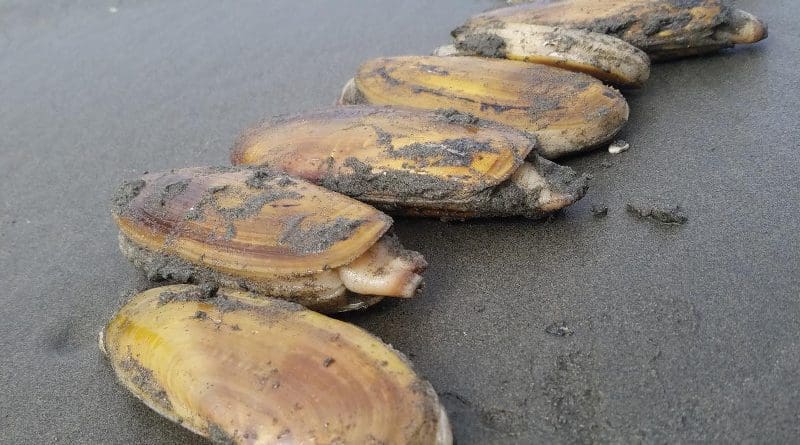Even Razor Clams On Sparsely Populated Olympic Coast Can’t Escape Plastics
Portland State University researchers and their collaborators at the Quinault Indian Nation and Oregon State University found microplastics in Pacific razor clams on Washington’s sparsely populated Olympic Coast — proof, they say, that even in more remote regions, coastal organisms can’t escape plastic contamination.
Microplastics are pieces of plastic smaller than 5 millimeters that are either intentionally produced at that size, or break down from synthetic clothing, single-use plastic items, or other products. These particles enter the environment and pervade freshwater and marine environments, soils and even the air we breathe.
Britta Baechler, the study’s lead author and a recent graduate of PSU’s Earth, Environment and Society doctoral program, analyzed the concentrations of microplastics in razor clams collected from eight beaches along the Washington coast and, after surveying recreational clam harvesters,estimated the annual microplastic exposure of those who eat them.
The Pacific razor clam is one of the most sought-after shellfish in Washington. The state’s Department of Fish and Wildlife said that during a recent season, the recreational razor clam fishery saw more than 280,000 digger trips with diggers harvesting 4 million clams for the season. It’s also a key first food, cultural resource, and vital source of income for members of the Quinault Indian Nation.
During the study, a total of 799 suspected microplastics were found in the 138 clam samples, 99% of which were microfibers. On average, clams had seven pieces of plastic each.
Clams from Kalaloch Beach, the northernmost site near the mouth of Puget Sound, contained significantly more microplastics than clams from the other seven sites. Though the study did not explore the reasons behind this, Baechler noted that there were no major differences in land cover types between Kalaloch and the other sites, but Kalaloch is the closest in proximity of all sites to the densely populated Seattle metro area.
Baechler’s team compared whole clams — minimally processed as if being consumed by an animal predator — and cleaned clams — gutted, cleaned of sand debris and grit, and prepared as if being eaten by a person. They found that in thoroughly cleaned clams, the amount of microplastics was reduced by half.
Baechler said this bodes better for people — 88% percent of the survey respondents reported cleaning clams before eating them — than for ocean predators that aren’t afforded the luxury of cleaning clams prior to consumption.
Surveys of 107 recreational harvesters determined the average number of razor clams consumed per meal and the number of meals containing clams each year. Combining consumption information with the average number of microplastics per clam, the researchers estimated Olympic Coast razor clam harvester-consumers were exposed to between 60 and 3,070 microplastics per year from razor clams for those who thoroughly cleaned their clams before eating them, or between 120 and 6,020 microplastics a year for those who ate them whole without removing the guts, gills or other organs.
“We don’t know the exact human health impacts of microplastics we inevitably ingest through food and beverages,” said Baechler, who now works as an ocean plastics researcher at Ocean Conservancy. “Our estimates of microplastic exposure from this single seafood item are, for context, far lower than what we likely take in from inhalation, drinking bottled water and other sources, but no amount of plastic in our marine species or seafood items is desirable.”
Baechler and Elise Granek, a professor of environmental science at PSU, said that everyone has a role to play in reducing plastic pollution in the marine environment — from plastic producers and product designers who can develop effective upstream pollution control solutions to consumers who can make substitutions in their daily lives to reduce their plastic footprints.
“We all have become dependent on plastics for our clothing and packaging, and the more plastic we use, the more likely it’s going to end up in our drinking water, our food and our air,” Granek said. “All of us have a responsibility to do what we can to limit the amount of plastic that we’re using.”

